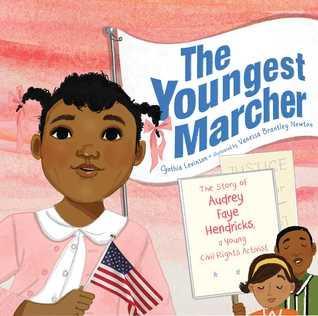
The Youngest Marcher
Read Aloud Book: The Youngest Marcher
Story: Mary Watson
Illustration: Mary Watson
ISBN-13: 978-0688141332
C3 Framework Key term: Democratic principle: A principle that should guide the behavior and values of institutions and citizens in a democracy.
Handouts
Radio and Television Report to the American People on Civil Rights, June 11, 1963 (PDF version only)
Download and Print the PDF
Synopsis
Audrey Faye Hendricks wanted to help end segregation in Birmingham. Although she was young, she marched and fought for integration alongside the adults. When she heard their plans to picket and march and fill the jails she stepped up and volunteered. She marched in the first youth march in the summer of 1963. She went to jail for seven days and on her fifth day they couldn’t fit one more person into the cells. Although it was difficult, she fought for what she believed in. Audrey and the other children who marched that summer inspired youth protests all over the country. This event, and a later event in Alabama State University, prompted President Kennedy to take action.
Discussion
Provide a historical summary: In 1963, hundreds of college students and students in the elementary, middle, and high school grades marched in the Birmingham Children's Crusade. Their plan was to peacefully walk downtown to talk to the mayor about integration of schools. The local police stopped the children using fire hoses and police dogs. Many children were arrested. Say: Although Audrey was young, Audrey volunteered to march for her beliefs. She made this choice knowing the risk. Ask: Why do you think she did this? Say: Some youth were encouraged by parents and elders in the community, who told them that their generation will make a difference. Others liked to study and wanted to compete academically with white children. And other children wanted to have the same school facilities and educational opportunities as white children. Some of the young marchers defied their parents and teachers by skipping school and joining the march.
Ethics Connection
Show students a segment from President Kennedy’s civil rights address on June 11, 1963 (A transcript of this segment is included in this lesson plan; for a transcript of the full speech, see the American Presidency Project). Write on the board: American Ideals versus American Realities. Ask: How does President Kennedy contrast American ideals and realities in his speech? Say: President Kennedy knew that passing an Act that protects the rights of African American people is not enough to change their lives. He needed American citizens to buy into this law and support it in their everyday actions. In groups, imagine you are in 1963 and you need to self-reflect what you can do to support the new civil rights law. Make a list of things you can do, and how you can encourage others to support equal opportunities and respect to all people.
Fun Activity
Say: We are going to make picket signs like the ones Audrey and the other child marchers used. In groups, you will come up with a short phrase about equality and then on a poster board you will write your phrase and add an illustration. On a separate sheet of paper, you will write what equality means to you and how your phrase represents the principle of equality. In your writing, you should also explain the decorations on the sign.